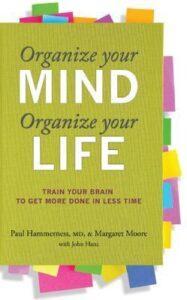Tame the Frenzy
August 17, 2021
Tame the Frenzy
by Rochelle Melander
It’s nervous work. The state you need to write in is the state that others are paying large sums to get rid of. — Shirley Hazard
 In Organize Your Mind, Organize Your Life: Train Your Brain to Get More Done in Less Time, authors Paul Hammerness, M.D., Margaret Moore, and John Hane use research from brain science to outline a six-step plan to help people get more done. According to the authors, our fast-paced world has left most of us feeling frazzled and overwhelmed. Now instead of having to deal with the mail and a handful of phone calls, we are bombarded with incoming information in hundreds of different but all immediate forms. It’s hard to know which one to pay attention to first. No wonder it’s hard to get through the day let alone write a book and manage the world of social media.
In Organize Your Mind, Organize Your Life: Train Your Brain to Get More Done in Less Time, authors Paul Hammerness, M.D., Margaret Moore, and John Hane use research from brain science to outline a six-step plan to help people get more done. According to the authors, our fast-paced world has left most of us feeling frazzled and overwhelmed. Now instead of having to deal with the mail and a handful of phone calls, we are bombarded with incoming information in hundreds of different but all immediate forms. It’s hard to know which one to pay attention to first. No wonder it’s hard to get through the day let alone write a book and manage the world of social media.
The authors present six tools (they call them “Rules of Order”) to help people get organized and finish projects. Their tools are enormously helpful for those of us who write. Here’s a summary of their tools:
- Tame the Frenzy. Calm one’s emotions in order to focus on a task.
- Sustain attention. Sift through multiple demands, choose a priority, and focus on task.
- Apply the Brakes. When we are tempted to travel off course (look a squirrel!), stop and focus on task.
- Mold Information. Use working memory to retrieve information and use it in our work.
- Shift Sets. The ability to be flexible in our thinking and shift our focus.
- Connect the Dots. The ability to use all five steps above and see the big picture.
Over the next few months, I will be writing a series of articles on these tools and how they apply to the writing life. Today, I will be tackling the first tool: tame the frenzy. (Please note: This series is adapted from a series of blog posts I wrote in 2013.)
Tool: Tame the Frenzy
What it is: This is the ability to notice and calm our emotions so that we can focus on the task at hand.
What frenzy looks like for writers: For many of us, our work is not just our work, it’s who we are. We write as an extension of our living. As we give voice to characters or explain how things work, we are figuring out the world, what we believe, and how we fit. Because of this, writers can be emotional about their writing. So many of us come to our work riddled with the three emotions that the writers of Organize Your Mind, Organize Your Life say are not helpful: anxiety, sadness, or anger. We worry about being good enough, we worry that other writers are doing better, we get sad when our work is overlooked, we get angry at those who don’t respect us, and on and on it goes. Who can write with that kind of drama playing out in our heads?
On top if that, frenzy also shows up as the nasty inner editor voice, often called “gremlins” after the 1984 movie of the same name. If you’ve ever tried to write or publish anything, you know what the frenzy sounds like: “This won’t be good enough to sell, I don’t know how to do this, no one will buy this, I’m scared, I don’t have the right words, I’m a loser, I should give up.”
How to tame the frenzy: According to the authors, the best way to tame the frenzy is to engage our pre-frontal cortex or the thinking area of the brain. If we can get our mind to put aside the feelings and focus on the writing puzzle, we can often move to step two: sustained attention.
If we cannot get our mind to stop with the shenanigans, we need tools to help our brain calm down and focus. Here are some that I’ve found helpful:
+Journaling. Write one to three pages about all of the inner angst you are feeling at the moment. Commit all of your worries to the page. And, if possible, ask the journal to hold the worries (and your gremlins) until you are done writing for the day.
+Tapping. When our emotions threaten to overwhelm us, we may need to take a break to deal with what’s happening. I find tapping to be a very helpful tool (EFT). Check out this post from my friend Liesel Teversham to learn how you can use tapping to heal: The Upside of Saying No.
+Think! Engaging in writing research or even doing a word or number puzzle can help kick in the pre-frontal cortex and move you toward analytical thinking.
The Writing Life. Taming the frenzy is often more than the daily task of setting aside emotions so we can work on our writing project. As writers, we need to cultivate a frenzy-free life. For me, this means creating the kinds of habits that tame the frenzy and allow me to sustain attention. So, taming the frenzy includes:
*exercise
*healthy eating
*journaling
*meditation
*acknowledging difficult emotions and practicing self-compassion
*connecting with other writers
Your turn. How do you tame the frenzy and write? Stop by the blog and share your brilliant ideas!
NOTE: The books links lead to the Write Now! Coach bookstore on Bookshop.com. Write Now! Coach receives a small percentage of your purchase, which helps to support this blog.
 About the author. Write Now! Coach Rochelle Melander is a certified professional coach, experienced publishing strategist, and the author of 12 books, including Level Up: Quests to Master Mindset, Overcome Procrastination and Increase Productivity and Mightier Than the Sword: Rebels, Reformers, and Revolutionaries Who Changed the World through Writing. She helps people write and publish books that transform lives. She’s the founder of Dream Keepers, a writing workshop that supports children and teens in finding their voice and sharing their stories. Sign up for her Write Now! Tips Ezine at https://www.writenowcoach.com.
About the author. Write Now! Coach Rochelle Melander is a certified professional coach, experienced publishing strategist, and the author of 12 books, including Level Up: Quests to Master Mindset, Overcome Procrastination and Increase Productivity and Mightier Than the Sword: Rebels, Reformers, and Revolutionaries Who Changed the World through Writing. She helps people write and publish books that transform lives. She’s the founder of Dream Keepers, a writing workshop that supports children and teens in finding their voice and sharing their stories. Sign up for her Write Now! Tips Ezine at https://www.writenowcoach.com.









